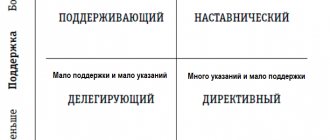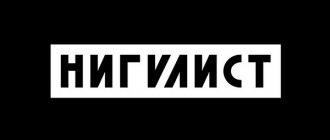.
It may seem that leadership is the same as the process of leadership itself, but if you look at the situation in detail, they are different things. The manager is responsible for ensuring that the company’s employees carry out everything efficiently and accurately according to his orders. The leader tries to direct employees to work in one or another area of activity. According to the manager, every employee of the enterprise should be interested in success, therefore he is obliged to work creatively, his impulses should benefit the enterprise. As practice shows, model 2 of behavior is much less common, although the effectiveness is higher.
Leadership theory
The most popular theory is that leaders are born, not made, that is, the theory of character, or “great man.” This refers to the innate inclinations and abilities of a person that help a person become a leader.
The second theory is situational. According to it, innate characteristics alone are not enough; certain conditions of the external world and the relationship between these conditions and a given individual are also needed. That is, the role is played by the extent to which the situation allows the leader to express himself.
A leader has a strong belief in his own beliefs, which inspires those around him.
If a person strongly believes in his beliefs, then more often than not, such a person will stick to his values in all situations, which affects the overall vision of the leader and the future of the company. But this should not mean that the leader ignores the opinions of all people who think differently. A good leader is a flexible leader. A good leader will listen to the opinions of others, adapt his ideas and develop them, taking into account the suggestions of his team. Adapting your own ideas is not a change in your own beliefs.
Research shows a high degree of correlation between feelings of uncertainty and stress. Prolonged feelings of uncertainty often lead to depression, which is very detrimental to any organization. If your employees are unsure of what decision you have made about a new idea, or they feel that the leader changes his decisions too often, then they will not be able to focus on their work and their productivity will be minimal. Such a leader is most often no longer respected, and his instructions are not taken seriously.
There is a famous story about the former head of Apple. Steve Jobs demonstrated a very strong stance on his beliefs. For example, when the first iPhone was released, many said that people prefer a traditional keyboard, and no one would want to use a touch one. Jobs always responded to such arguments that people would get used to it. That's how confident he was in the correctness of his decisions.
Leader Features
The most important feature of leaders is charisma. Read more about this in the article “Charisma: what is it in a person and how to develop it.” Other characteristics of a leader include:
- high level of aspirations;
- a high self-evaluation;
- self-esteem;
- self-awareness;
- adequate assessment of the strengths and weaknesses of one’s personality;
- the desire for success (importance and responsibility), recognition, power (managing people, directing them in a certain direction).
Of course, without certain competencies and abilities, a set of such qualities can give a completely different result. Therefore, other qualities of a leader include:
- above average intelligence, ability to solve complex and abstract problems;
- independence, resourcefulness, business activity, readiness for action, initiative;
- the ability to see the situation broadly, to consider beyond the particular;
- knowledge and experience in a specific field;
- good health, developed imagination, attention, memory, thinking;
- emotional balance and stress resistance;
- the ability to self-regulate (the ability to relieve stress);
- communication skills;
- ability for psychoanalysis;
- eloquence;
- visuality (external attractiveness).
Thus, all the qualities of a leader can be divided into general, specific, personal-business and psychological-pedagogical.
How to develop leadership qualities in yourself - a list of ways
It's not so easy to step up and become a leader if you weren't born one. This is work and work on yourself, and most importantly, the desire to change and change your life. It is not enough to be in good physical shape and health; a lot depends on your character.
What you should definitely do:
- enroll in special courses where they will help correct all speech errors and incorrect diction - it is difficult to be a convincing speaker with defects;
- read more, especially the classics - this affects conversation and vocabulary;
- Every day, talk and argue with the mirror for 5-10 minutes - only the first few days it looks strange, then it helps to become more convincing.
You can enroll in a dance school or gym. This will help you get in good physical shape and add self-confidence. In addition, it relaxes and relieves emotional stress.
The business-result company will help you develop all the necessary abilities - we take a comprehensive approach to each task, help you identify the main and secondary goals, so as not to get scattered trying to do everything at once. We train managers and develop motivation schemes so that your team begins to reach any, even the most daring, heights.
Types of Leadership
Leadership can be emotional, business and informational.
Emotional
It arises on the basis of sympathy in the group between the participants and the leader. An emotional leader creates a favorable psychological climate, inspires trust, relieves tension, and instills confidence. This is the heart of the group. You can always contact him. As a rule, an emotional leader appears in informal groups.
Business
This type of leadership is found in formal teams. A business leader is distinguished by high competence, the ability to solve problems, and organize activities. These are the hands of the collective. A business leader builds relationships and communicates closely with management.
Informational
The information leader is the brain of the team. He is well versed in information flows and is highly erudite. People turn to the information leader for help and advice. He helps you search for information or answers questions himself.
The ideal option is a combination of all three types in one leader, but this rarely happens. More often there is a combination of a business leader and an emotional or informational one.
The direction of leadership can be:
- Constructive. Helps achieve organizational goals.
- Destructive. The leader's aspirations are detrimental to the organization.
- Neutral. Does not affect performance.
Long-term vision
Taking the long view and seeing potential in unexpected or unnoticed things is an invaluable leadership quality. The management of any company wants to know what will be in demand in their industry tomorrow, how to solve the problem with less cost and greater efficiency, what products everyone will use in the future. Suffice it to recall services that were very popular in the past, but over time they were replaced by more original ones - who knows how things would have turned out in these companies if they had a forward-looking vision?
How to improve long-term vision
BOOKS:
- Luc De Brabander, Alan Iny "Think in Other Formats"
- Dave Stewart, Mark Simmons "The Game of Business." Spaghetti ideas, garbage collectors, Viagra and other ingredients of creative doping"
- Scott Belsky, Bringing Ideas to Life. How to bridge the gap between vision and reality"
- Ivan Bubnov “Vision as a resource. Strategic session with yourself"
- Bill Torbert "Action Research"
VIDEO:
Rosalinda Torres: " How to Become a Great Leader "
FREE CLASSES:
“Netology”: How to evaluate the result of personal development
QUESTIONS AND ASSIGNMENTS:
- Think about your ideal job - what is it like? What does it include?
- Make a list of 50 of your accomplishments (minimum). Think about it, is there something that unites them? Based on this information, create a chronology of future achievements—just a list with approximate dates will do.
- Talk about the future as if it were the past. Imagine that your plans came true, how the world has changed?
- Make a list of so-called places where you would not like to be - kind of flags, what kind of life you definitely do not want. And make sure that your actions do not lead there.
Types of Leadership
Among the types we can distinguish a leader, a leader in the narrow sense and a situational leader:
- The leader acts by suggestion. He is active, strong, physically developed, healthy, strives for success, self-confident, has the ability to adapt, is smart, has developed creativity and intuition, is tactful, sociable and easy to communicate.
- A leader has less authority than a leader. He also convinces and inspires, but he also motivates using the “do as I do” method.
- A situational leader emerges in a specific situation due to his strong abilities needed at the moment.
In relation to the attitude of the team to the leader, it is customary to distinguish the following types:
- "One of us". He does not stand out among the group in any way, but is perceived by her as first among equals.
- "The best of us." In almost all qualities he stands out from the group and acts as a model.
- "Good man". Valued and distinguished by the team for his moral qualities.
- "Servant." Considered as an intermediary, a representative of interests.
The same leader can be perceived differently by team members, that is, he belongs to several types at once. In general, there are leaders in any group, both official and unofficial, both destructive and constructive. For example, the example known to everyone since school was the prefects (formal leader) and hooligans (informal leader) of the class.
Demonstration of leadership qualities
It is necessary to show your capabilities not only with words, but also with actions. Keep your gaze confident and firm, as is your position. Facial expressions and gestures are under control. Do not look away or hide during conversations. Treat your interlocutor only with respect, and do not raise your voice.
You should maintain your posture and appearance: both in clothing and in your entire image. Dress appropriately for your position. You should not come to a leadership position in a sweater with cakes or provocative makeup.
Leader and manager
Leadership is a formal position of a person that has nothing to do with his personal qualities, although they influence the leadership style. Leadership is a position occupied by a person due to his individual personal characteristics. Perhaps this is the main difference.
Among the similarities are the following:
- orientation to the goals of the organization;
- communication with people and groups of people;
- motivating employees and other influence on them;
- creating and maintaining a favorable psychological climate.
Sometimes a manager and a leader are considered synonymous if these roles coexist in one person. But this doesn't always happen. It is also possible for the leader to identify a leader or leaders of the group and identify informal leaders.
The leader is interested in and participates in the work process. He consults, gives advice, supports feedback and pushes people to independence, leads, and sets a personal example. The manager may not do this; he may not even know his subordinates personally. Leaders do not provide ready-made solutions; together with other team members, they develop creative and problem-solving thinking.
Leadership can be transferred from one person to another depending on what knowledge, abilities, skills, qualities and abilities are needed to solve the current problem.
The nature of the power of a manager and a leader differs. The leader is endowed with authority and status. The leader wins the favor of the group and motivates them to successfully complete tasks with his authority and charisma. The power of authority is many times stronger than the power of authority. But this same power is easier to lose, since it is based on respect for the very personality of the leader.
Thus, we can highlight the following differences between a leader and a manager:
- The manager organizes all activities; the leader is largely responsible for vertical psychological relationships.
- The leader is officially appointed immediately after the organization is created, the leader is nominated spontaneously through the relationships of group members.
- The leader manages all activities and external relations of the organization; the leader is responsible for communication, activities and the nature of relationships within the group.
- The leader controls and rules, the leader himself fulfills the norms of the organization.
- The manager focuses on the prescribed rights, the leader - on the moral and psychological norms that have arisen in the group.
- Leadership is more stable, leadership depends on the relationships and opinions of team members, as a result of which leadership is changeable.
Leadership is social influence, which is based on the principle of legal relations, distribution of roles, power, control and discipline. Leadership is a psychological influence based on perception, imitation, mutual understanding and suggestion. This is voluntary submission and free communication.
The leader is the top position in the legal social-role hierarchy. A leader is the top in the hierarchy of authority and prestige.
Behavior styles
It is often on the basis of behavioral style that a manager is distinguished from a leader. This behavior is usually determined by the individual qualities of a person, so it cannot be said that some of them are characterized by one style, and another by another.
Experts have identified 3 styles of managing a work team: authoritarian, democratic, liberal.
An authoritarian management style is typical for managers. This is constant strict control of the performed duties of employees and their punishment in case of certain problems. With an authoritarian management style, the individual qualities of the employee are not taken into account. It is considered as a robot needed in the company to perform certain functions. This management style is productive for the company. It is profitable and productive. Employees who do not feel needed sooner or later quit, thereby losing everything that has been earned over a long time.
Democratic style is characteristic of leaders. The opinion of even the most ordinary employees is taken into account, which is extremely important. The key decision on almost all issues is made by general voting. A leader using this strategy feels like an employee like other officials, regardless of status. The democrat always listens to the wishes of employees and does everything to make everyone feel comfortable working in such a company. This style is the most effective. Each employee sees that the leader understands, values and respects him. They try to repay him in kind, doing their work efficiently and striving for new heights. There is a friendly atmosphere in the team, employees communicate well with each other and are ready to help each other at any moment (on issues that directly relate to work).
The liberal style is characteristic of those managers who are not interested in the success of the company or the needs of employees. They shift management responsibilities to other employees, and they themselves do not even know who works for them. This is the most failed management style that leads a company to bankruptcy.
Features of a leader
As I already said, the best option is a combination of management and leadership in one person. The leader-manager does not order or put pressure on employees. He clearly explains to them the goals and leads them towards these goals. In addition, the leader-manager:
- Able to perceive and accept common needs and problems, and take responsibility for solving them.
- Able to organize joint activities: formulating tasks that are relevant for the entire team, creating conditions for their implementation, taking responsibility, taking into account the interests and capabilities of each participant, planning work taking into account these features, considering and recognizing opposing opinions, distributing responsibilities, motivating staff.
- He is distinguished by empathy, tactfulness, trust, ability to communicate, sensitivity: he will listen, help, share secrets, defend interests, resolve conflicts.
- Able to represent the entire team on his own behalf, express a common opinion, take initiatives to higher organizations to meet the needs of the team.
- Knows how to emotionally and psychologically influence, attract people without coercion or orders, convinces and encourages.
- He thinks positively, which instills self-confidence in the entire team.
In conclusion, I want to say that the mere presence of inclinations and leadership abilities does not guarantee anything. As we see, many qualities of a leader are acquired in the process of life. Abilities help to develop them better and faster.
Flexibility
To prevent your persistence from turning into obstinacy, it is worth developing another systemic quality of a leader - flexibility. This is the ability to switch and easily abandon non-working strategies. A leader always has a “Plan B” and a “Plan C” in case something goes wrong. One of the most important soft skills in a world where every day is different from the previous one.
How to improve flexibility
BOOKS:
- Susan David, Emotional Flexibility. How to learn to enjoy change and enjoy work and life"
- Gareth Moore Brain Trainer. How to develop flexible thinking in 40 days"
- Srini Pillay “Jew's harp, sprinkle, marai and taste. Unlock the power of a relaxed brain"
VIDEO:
- Tatyana Vladimirovna Chernigovskaya “ Training the brain: speed, cognitive flexibility, decision making ”
- Irina Khakamada, blog about leadership on YouTube in general and answer to the question “ How to develop flexibility ” in particular
QUESTIONS AND ASSIGNMENTS:
- What topic do you understand best? Find someone who wants to dive into it and try to teach them.
- Remember what games you loved when you were a child? Find games that you might have also enjoyed as a child. With age, a person loses flexibility - and we’re not just talking about physical abilities.
- Imagine that another person was in your place - fictional or real. What would he do first? What would you say to the people around you, how would you solve current problems?










